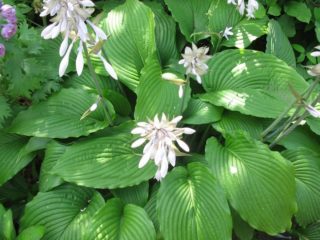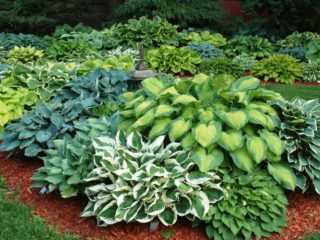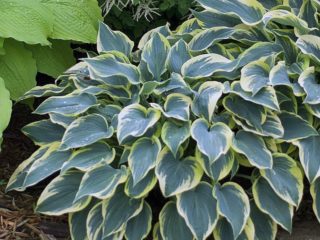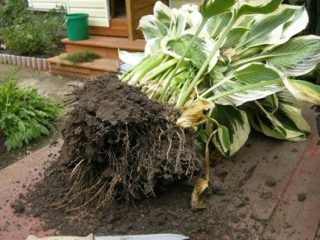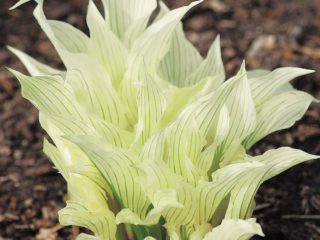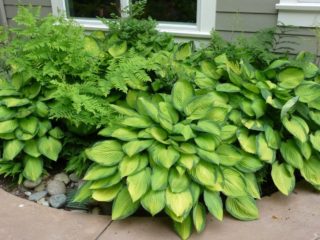Content
Planting and caring for hosta at home is possible, although the plant is considered a garden plant. It is necessary to choose the right container, prepare the soil and provide an integrated approach. For planting at home, it is worth choosing hosts of certain categories.
Can hosta be grown as a houseplant?
Hosta is attractive for its magnificent leaves, which is why many people want to grow it at home. The plant is unpretentious, so with proper organization of the process this is quite possible.
Which hosta can you plant at home?
You can plant hosta in a pot at home, but for this it is better to choose certain varieties. There are several categories of plants based on growth. To grow hosta at home, you should choose medium-sized varieties:
- category D – dwarf varieties up to 10 cm high;
- Mini category with hosts up to 15 cm;
- plants of category S 15-25 cm high;
- category M with medium-sized specimens 25-45 cm.
Hostas of categories L (45-70 cm) and G (from 70 cm) are best left for the garden.
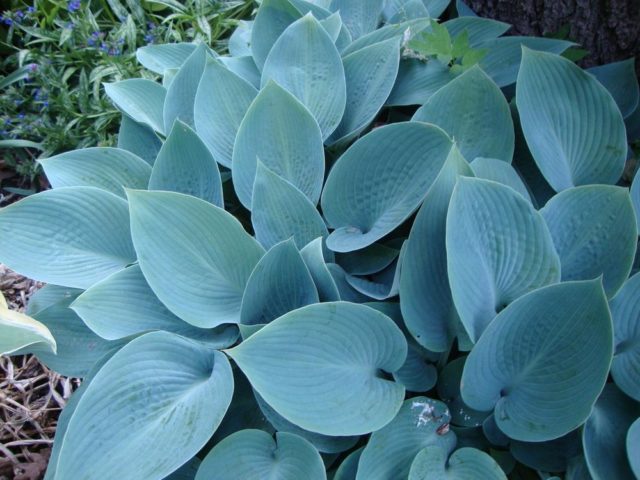
One of the options for an apartment is the dwarf variety Blue Moon, it has attractive blue leaves, and large flowers have a lavender hue
How to plant hosta in a pot
Grow hosta at home in a pot. If the plant was purchased in a container, then replanting it into a new container should wait until the root system is strengthened.
Selection of capacity
First you need to pick up a small pot. A larger container will be needed when the flower grows. At home, you can plant hosta in a ceramic, clay, or plastic pot. Small holes at the bottom are required.
Before planting hostas, the selected pot should be disinfected. To do this, use potassium permanganate or an alcohol solution, wiping the container from the inside.
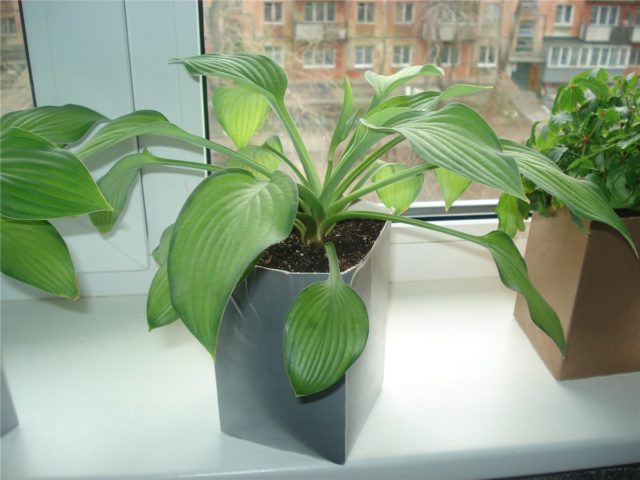
Hosta can also be grown in a box; the inside of the material should be waterproof, and the outside of the container can be covered with colored paper or cloth.
Soil preparation
In order for a hosta to grow successfully in a pot at home, the soil must be properly prepared. The substrate must be sterile - the presence of fungi and pathogens will lead to the death of the plant. To disinfect, the soil is spilled with a solution of manganese or kept in the oven for 1-2 hours, and then in the freezer for a day.
You can take ready-made soil or prepare it yourself. It should consist of peat, vermiculite, perlite, but 60% garden soil.
The soil should be slightly acidic or neutral, moderately moist. Hostas do not like heavy soil and sand.
For growing at home, drainage is required; a layer of 3-4 cm is sufficient. It is recommended to place humus under it, which will become a source of nutrients for the rhizome.
Landing algorithm
Features of the process at home depend on the planting material. If seeds are used, then the algorithm is as follows:
- Soak the material for half an hour in a growth stimulator. You can use aloe juice, Epin, Kornevin. It is possible to replace the drugs with monthly cold hardening.
- Pour a drainage layer into a disinfected pot and place pre-moistened soil.
- Sow seeds and cover with soil. The thickness is no more than 1 cm. Lightly compact the soil. If you need a lot of sprouts, then plant a seed per 1 cm².
- Cover the pot with glass. You can use a plastic bag or a cut plastic bottle.
- Monitor soil temperature. It should be between 18-25 °C until shoots appear. This takes 2-3 weeks.
- Regularly moisten the soil and remove condensation in a timely manner. The pot can be kept in a shaded place.
- With the appearance of the first shoots, the hosta needs more light, but direct sunlight is excluded.
- When the first pair of leaves appears, the seedlings are picked. You can move the seedlings into individual pots. Sprinkle fine sifted sand on top of the soil.
- At first, watering should be from the bottom - you need to place the pot in a tray with water.
- The cover must be removed daily for 1-2 hours. In the absence of gusty winds and temperatures above 18 °C, it is better to expose plants to the open air.
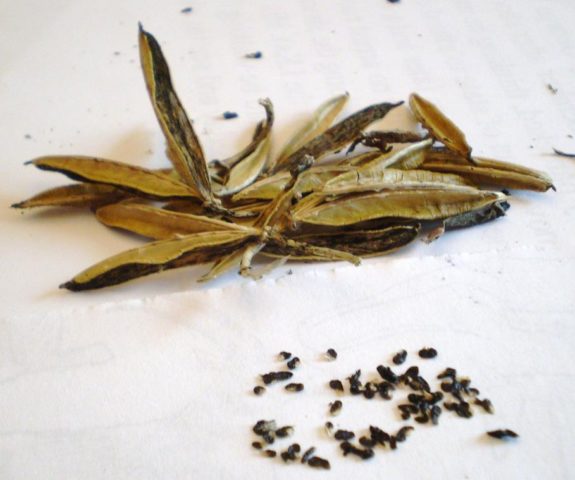
You can collect seeds for planting yourself; do this in early autumn - the seed pods turn brown and open
Hosta seeds are usually planted in early March or late February. Growing in this way is rarely practiced, since it takes a lot of time and does not guarantee the preservation of all varietal characteristics. Much more popular is planting seedlings or rhizomes with cuttings. The algorithm in such cases is as follows:
- Fill the disinfected pot with a drainage layer halfway with soil and place the plant in the center. Spill the soil 2 hours before planting
- Fill the free space around with soil, compacting it a little.
Growing hosta indoors
For a hosta to successfully exist at home, it is important to provide a certain microclimate in the room, regularly water and feed the plant, and observe the specifics of winter care.
Indoor microclimate
Hosta prefers a dry and cool room. When it is too warm, wilting begins. If the room temperature is room temperature, then the plant must be sprayed regularly. When choosing a suitable place for a pot, you should consider a number of factors:
- hosta prefers shade;
- there should be no drafts, this is especially important for a young plant;
- varieties with variegated colors need partial shade, but sunlight in the morning and evening hours;
- plants with bright or striped leaves need more light;
- varieties with blue foliage are suitable only for shade, and require sunlight only for 2 hours a day.
In warm weather, you can put the hosta in a pot outside.
Hosta in a pot, as in the photo, grows successfully indoors, but in the summer they will perfectly complement their outdoor counterparts.
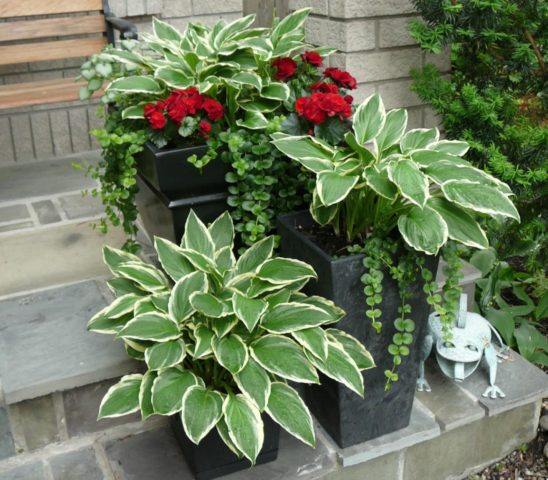
In an apartment in the summer, the hosta can be placed on a balcony or loggia
Watering and fertilizing schedule
Caring for a hosta flower at home means watering and feeding it in a timely manner. The plant loves moisture, but indoors you need to remember about moderation. Water the hosta when the soil in the pot begins to dry out.
In the autumn-winter period less moisture is needed. In summer, the hosta is watered every day. For some varieties and on particularly hot days, moisturizing may be required twice a day.
It is better to water the plant early in the morning or in the evening. If the house is warm and dry, then the condition of the soil is checked daily. When 2-3 cm of soil on top is dry, moisture is required. The water should be settled and at room temperature.
Water the plant slowly. With a strong flow of water, the earth does not have time to moisten sufficiently, since most of the moisture comes out of the drainage holes.
If the soil is dry, loosen the soil before watering. When the soil dries out completely, place the pot in water for 1-2 hours.
The plant is fed in spring and autumn. Feeding is required during flowering. Hosta prefers organic fertilizers:
- husks of sunflower seeds or pine nuts;
- rotted bark;
- leaf soil;
- garden compost;
- corn cobs (must be chopped).
Mineral fertilizers are a source of vitamins. Effective complex products of prolonged action Bazakot, Osmokot.
How to care for hosta at home in winter
Hosta at home in a pot sleeps in winter in the same way as a plant grown outside. During this time, it is removed away from radiators and other heat sources. It is better to place the pot in a cool room.Some people keep it on the balcony if the temperature there is at least 10-15 °C.
Watering hostas in pots in winter is minimal, but the soil should not dry out. You need to moisten it a little. It is enough to monitor the condition of the soil 1-2 times a month.
In the spring, the indoor hosta wakes up faster than its relatives outside. During the day it can be exposed to fresh air, but kept indoors at night. If the plant does not wake up, then it should be kept in the apartment until it warms up.
Transfer
The hosta needs to be replanted as it grows. This is usually required when the plant is 2 years old. The algorithm is simple:
- Carefully remove the hosta from the pot along with some of the soil above the tuber. Carefully release the roots.
- Place the plant in the center of a new pot with drainage and some soil.
- Fill the empty space with soil.
- Add small pebbles. A layer of 3-4 cm is enough. This measure prevents the soil from drying out quickly, preserves the roots and does not allow parasites to reach them.
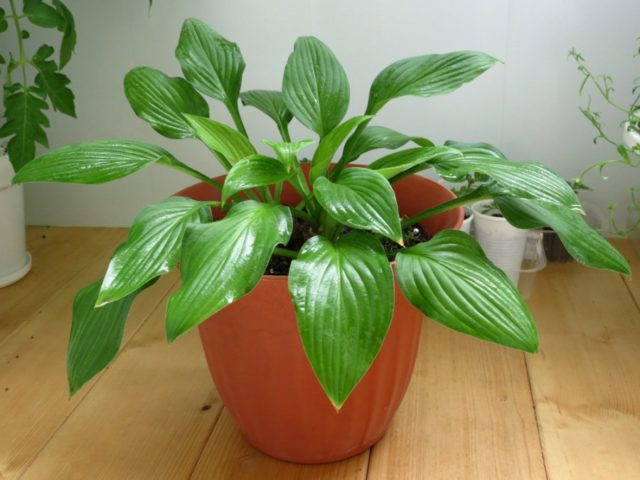
The hosta in a new pot should be positioned so that there is room under the leaves for watering without the risk of damaging them.
Pros and cons of growing hosta in an apartment
Growing hostas at home has many advantages:
- the plant is mobile - it can be rearranged not only within the apartment, but also taken out onto the loggia or street;
- excellent decorative value and compatibility with many indoor flowers;
- maintaining attractiveness for many years;
- less susceptibility to diseases and pests, especially the main enemy - slugs;
- unpretentiousness;
- no risk of death of peduncles and buds during frost in late varieties.
There are also disadvantages to growing hostas at home:
- the soil dries out faster;
- there is a risk of the pot overheating in the sun, which harms the roots;
- the soil must be changed every 2-4 years.
Sometimes hosts consider a shorter life expectancy at home to be a disadvantage. In an apartment it can feel great for 10-15 years, while it can grow successfully outside for more than 20 years.
How to keep hosta in a pot until spring
When you plan to plant a plant in open ground, it is recommended to purchase it in the spring or at the end of August. If the hosta was purchased in the cold season, then at home it will perfectly wait until spring in a pot. To do this, it must be buried in it with the buds. The hosta will quickly grow and can wait to be planted outside. It is better to do this at the beginning of summer.
In winter, the hosta can be kept on an insulated loggia, then watering is not required. If it is to be kept indoors, care should be the same as for a houseplant.
Pests and diseases
Hostas grown at home rarely suffer from pests. Their main enemy, the slug, simply cannot survive in a dry room. Nematodes can be a problem. These small worms can be root, stem, or leaf. You will have to say goodbye to the affected hosta, and the remaining plants need to be treated. Most drugs are not suitable for indoor use; Bak Ecogel is allowed.
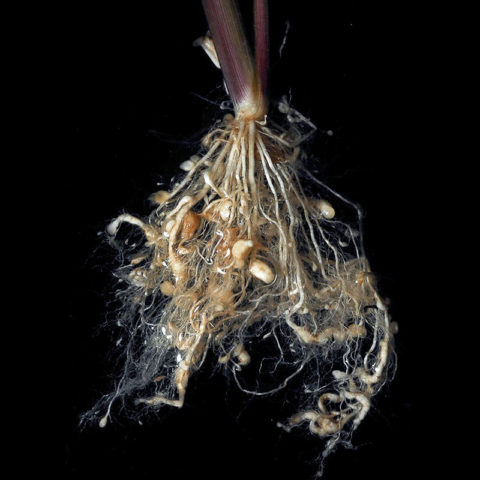
The root system is affected by root-knot nematodes no larger than 1-2 mm in size; swellings called galls appear, first yellow and then brown.
The main problem when growing hosta at home is disease. One of them is virus X. It is expressed as small round specks on the leaves that grow quickly. There is no treatment; the affected plant must be burned.
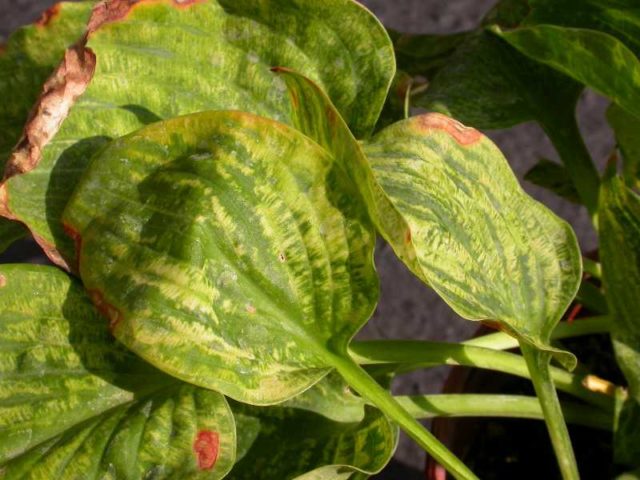
If infected with virus X, it is recommended to get rid of not only the diseased plant, but also the pot, work gloves, and all tools used must be disinfected
Another problem is phyllostictosis, also called brown spot. First, large brown-yellow spots appear, gradually merging, and a plaque forms. The affected plant along with the pot must be removed.
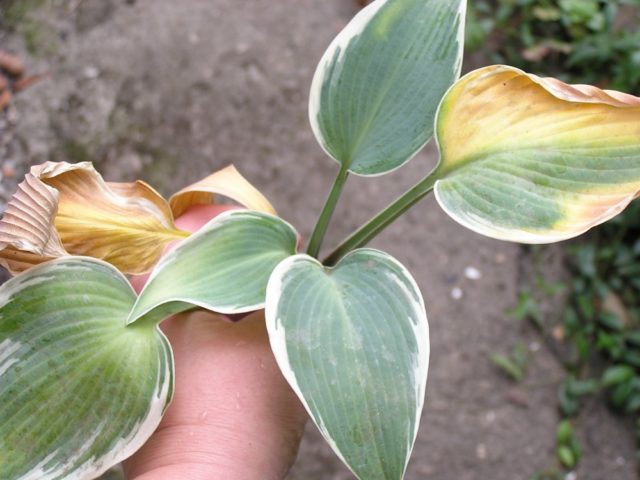
Spores affect all parts of the plant and the soil; for prevention, fungicides must be used
Hosta can develop root rot. The roots and base of the cutting turn black and rot. It is rarely possible to save an affected plant, so you need to get rid of it. For prevention, Bordeaux mixture and colloidal sulfur are used.
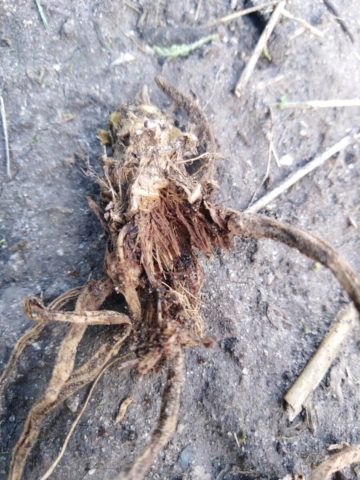
The cause of root rot may lie in an overabundance of fertilizers or contamination of the soil with a fungus.
Conclusion
Planting and caring for hosta at home does not require much effort. The plant is quite unpretentious; various varieties up to 50 cm in height can be grown indoors. It is important for the host to be watered in a timely manner, fed twice a year and protected from diseases and pests. In summer, the plant can be kept outside.
